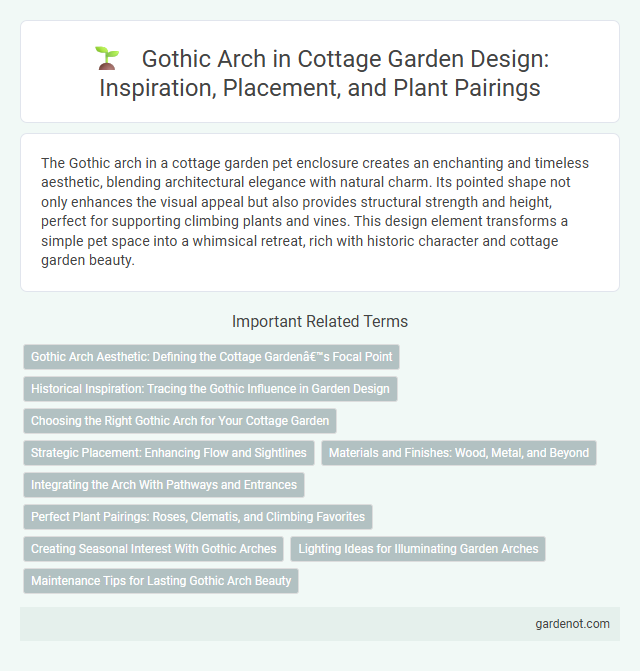The Gothic arch in a cottage garden pet enclosure creates an enchanting and timeless aesthetic, blending architectural elegance with natural charm. Its pointed shape not only enhances the visual appeal but also provides structural strength and height, perfect for supporting climbing plants and vines. This design element transforms a simple pet space into a whimsical retreat, rich with historic character and cottage garden beauty.
Gothic Arch Aesthetic: Defining the Cottage Garden’s Focal Point
The Gothic arch enhances the cottage garden's aesthetic by introducing verticality and intricate design, creating a captivating focal point. Its pointed silhouette contrasts with the softness of flowering plants, establishing an elegant architectural element that draws the eye naturally. This iconic shape echoes historic Gothic architecture, adding timeless charm and a structured visual anchor to the garden's informal layout.
Historical Inspiration: Tracing the Gothic Influence in Garden Design
The Gothic arch, originating in 12th-century Europe, profoundly influences cottage garden design by introducing verticality and intricate detailing reminiscent of medieval architecture. Its pointed arches and ribbed structures inspire trellises, gateways, and arbors, creating an atmospheric blend of romanticism and historical depth. This architectural element evokes a sense of timeless charm and spiritual elevation, enriching the garden's visual narrative with its distinctive historical resonance.
Choosing the Right Gothic Arch for Your Cottage Garden
Selecting the right Gothic arch for your cottage garden involves considering size, material, and design to complement the space and plantings. Opt for wrought iron or weathered wood structures that enhance the rustic charm while providing durable support for climbing roses or clematis. Incorporating detailed tracery or pointed arches can add authentic Gothic elegance, creating a focal point that blends historic style with natural beauty.
Strategic Placement: Enhancing Flow and Sightlines
The Gothic arch, strategically placed in a cottage garden, serves as a captivating focal point that enhances both flow and sightlines by guiding visitors through winding pathways and framing key garden features. Its towering silhouette naturally draws the eye upward, creating an inviting transition between garden rooms and encouraging exploration. Positioning the arch where pathways converge or near seating areas maximizes its visual impact, seamlessly integrating architectural elegance with natural beauty.
Materials and Finishes: Wood, Metal, and Beyond
Gothic arch structures in cottage gardens are often crafted from durable wood such as cedar and oak, prized for their natural resistance to weathering and rich textural grain. Metal elements, including wrought iron and galvanized steel, bring intricate detailing and enhanced structural support, often finished with powder coatings or rust-resistant paints to extend longevity. Beyond traditional materials, innovative composites and reclaimed wood offer sustainable, versatile options that blend rustic charm with modern resilience.
Integrating the Arch With Pathways and Entrances
The Gothic arch serves as a striking architectural element seamlessly integrated with cottage garden pathways and entrances, guiding visitors while enhancing vertical visual interest. Its pointed shape contrasts with the natural curves of surrounding plants, creating a balanced interplay between built structure and organic forms. Strategic placement of Gothic arches along winding paths or at entry points frames views and invites exploration, enriching the garden's enchanting atmosphere.
Perfect Plant Pairings: Roses, Clematis, and Climbing Favorites
Gothic arch structures create an enchanting vertical framework ideal for climbing plants such as roses and clematis, enhancing the lush, romantic aesthetic of a cottage garden. Perfect plant pairings include fragrant climbing roses intertwined with vibrant clematis flowers, offering contrasting colors and extended blooming seasons. These climbing favorites thrive on the arch's support, transforming the garden into a picturesque retreat filled with texture and natural elegance.
Creating Seasonal Interest With Gothic Arches
Gothic arches add striking vertical lines and intricate shapes to cottage gardens, enhancing seasonal interest through their architectural form. These arches support climbing plants like clematis, roses, and wisteria, which bloom at different times, ensuring continuous color and texture throughout spring, summer, and fall. Incorporating Gothic arches creates dynamic focal points that highlight seasonal changes and elevate the garden's overall aesthetic appeal.
Lighting Ideas for Illuminating Garden Arches
Gothic arches in cottage gardens create a striking architectural feature that benefits from strategic lighting to enhance their intricate design. Using soft, warm LED uplights accentuates the pointed arches and intricate tracery, casting dramatic shadows that create a mystical ambiance after dark. Solar-powered lights or low-voltage fixtures concealed in garden beds maximize energy efficiency while highlighting the vertical lines and curves characteristic of Gothic garden arches.
Maintenance Tips for Lasting Gothic Arch Beauty
Regularly inspect Gothic arches in cottage gardens for signs of wear, such as wood rot or metal rust, to ensure structural integrity. Apply weather-resistant treatments annually to protect materials from moisture and UV damage, preserving their intricate design. Trim surrounding plants carefully to prevent overgrowth that can obscure the arch and cause moisture buildup, maintaining both beauty and function.
Gothic arch Infographic

 gardenot.com
gardenot.com